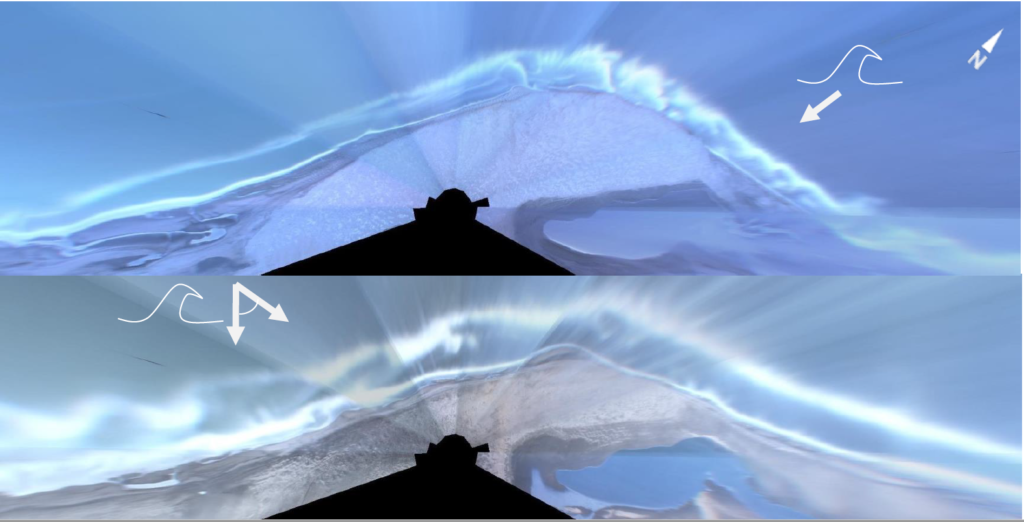Coastal safety
Mega-scale beach nourishments like the Sand Motor have a large impact on the coastline geometry, which affects the nearshore hydrodynamics and morphodynamics around the nourishment in several ways. Implications of the Sand Motor on sandbar behavior and swimmer safety have been studied in detail and elaborated below.
Hydrodynamics and swimmer safety around mega nourishments
by Max Radermacher
The tidal flow was observed to separate at the Sand Motor, generating very large circulating currents (eddies, diameter over 1 km). These eddies are associated with a complex, dynamic tidal flow field around the Sand Motor, which is less predictable than the regular tidal currents at unnourished beaches. Furthermore, around the most seaward point of the nourishment, the process is associated with off-shore directed currents. Due to the ongoing erosion of the Sand Motor, the generation of tidal eddies will stop automatically once the nourishment has become a lot smaller.
Highly variable sand bar patterns close to the beach are known to generate rip currents under specific incoming wave conditions. It was found that after two years, sand bars at the Sand Motor became significantly more variable than at the adjacent coastline. This might be related to the large changes in coastline orientation and beach slope at the Sand Motor, or to the structural beach erosion taking place at the nourishment.
The actual swimmer safety at a beach depends on more than the local nearshore hydrodynamics. The presence of beach users and their distribution over space and time are equally important. In order to determine the risk to swimmer safety at the Sand Motor, it was therefore assessed how hazardous hydrodynamic phenomena coincide with the presence of beach users.
The spreading of beach users over time is strongly linked to the weather. Suitable weather for a beach visit are days with high temperature, no clouds, no rain and weak wind. Since waves at the Dutch North Sea coast are typically generated by local winds, the wave height tends to be low on popular beach days. Most rip currents are formed by waves breaking on subtidal sandbars, which is not likely to occur during pleasant weather conditions. Hence, the risk of rip currents to swimmer safety is also relatively small.
This leaves tidal dynamics in the Sand Motor lagoon as the single largest risk for swimmers. Tidal currents in the entrance channel occur on a regular basis, determined by the tides, regardless of the weather conditions. In addition, beach users tend to cluster around the entrance channel near Kijkduin on crowded beach days. Nevertheless, it should be noted that the risks related to tidal currents in the entrance channel strongly depend on the channel’s morphological evolution. At the Sand Motor, the risk was high in the first years after its construction, but has gradually diminished over the years.

Impact of the Sand Motor on sandbar behavior
by Jantien Rutten
Sandbars are ridges of sand nearly parallel to the shore, located below the sea surface for at least part of the tidal cycle. Sandbars are one of the most dynamic morphological features in the nearshore zone at daily to interannual time scales. In response to wave forcing, sandbars can migrate towards the shore as well as away. When migrating onshore, sandbars may develop a characteristic pattern, often with some rhythmicity (see figure below, northern side). On the other hand, when migrating offshore, existing patterns are often destroyed, resulting in a straight sandbar (see figure below, western side). Bars with a pronounced pattern are associated with strong flows moving offshore, which are potentially dangerous to swimmers (rip currents). Therefore, understanding sandbar behavior is essential for swimmer safety.
A morphodynamic model was used to unravel the mechanism behind the formation of sandbar patterns along a curved coast. It was systematically explored which conditions promoted pattern formation, using a setup loosely based on observations at the Sand Motor. The passage of storms was schematized by a wave forcing with a wave angle that shifted between two directions every day. Simulations showed that the alongshore position of patterns, as well as their growth rate, vary with the local wave angle at breaking, i.e. the breaker angle. The local breaker angle depends on the offshore wave angle and the local orientation of the coastline. When the breaker angle increases, patterns form at a lower rate or not at all.
Under such angles, a strong alongshore current is generated, which slows down or even inhibits pattern formation. Moreover, the local wave height reduces because of wave refraction over the curved depth contours. In addition, this slows down pattern formation. Simulations suggest that patterns along a curved coast may develop faster than along straight coasts in wave climates wherein the coastline curve decreases the local breaker angles. The relatively high growth rate of patterns at a strongly curved coast under certain
wave climates implies that the strength.

More information on these topics can be found in this book.
